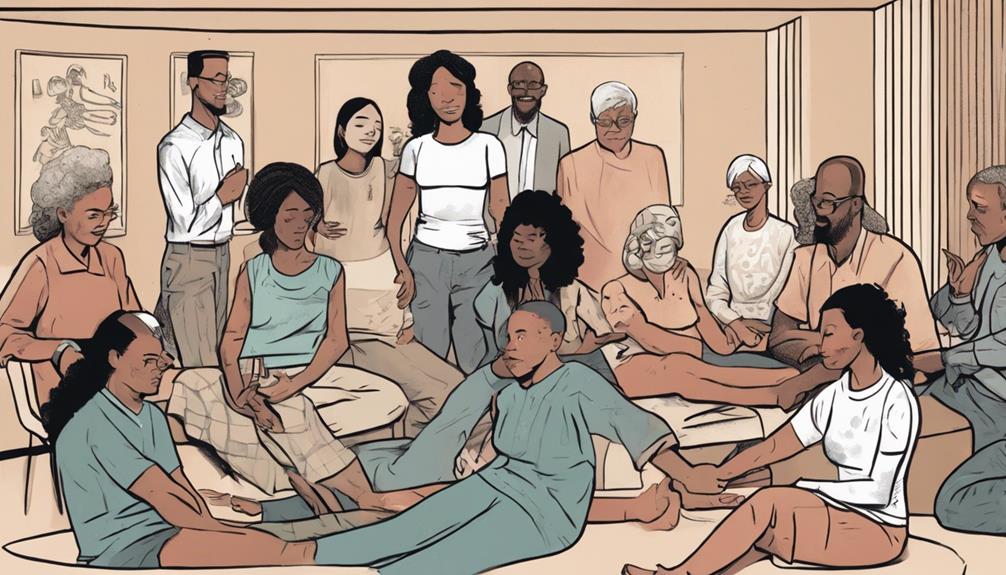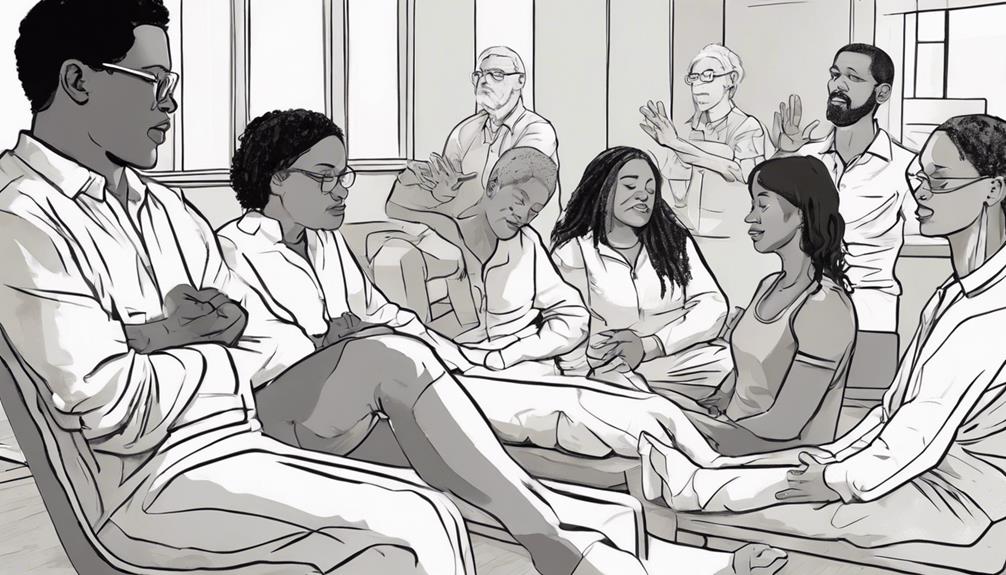Body-led grief work invites you to connect with your physical sensations as you process loss. By tuning into sensations like tension or restlessness, you allow your body to express emotions words can’t reach. Gentle movements and mindful breathing help release stored pain at your own pace, creating a safe space for healing. Approaching grief this way respects your body’s wisdom, guiding you toward emotional relief and resilience—an empowering journey that unfolds step by step as you explore more.
Key Takeaways
- Engaging the body through gentle movements and mindful breathing facilitates emotional release and somatic healing during grief.
- Listening to physical sensations like tension or restlessness guides pacing and emotional processing in a compassionate way.
- Body-led grief work emphasizes acceptance of natural responses such as trembling or crying as healthy expressions of loss.
- Incorporating mindfulness enhances awareness of bodily signals, supporting a non-judgmental and resilient approach to grief.
- Movement and breath work create a safe space for processing grief one step, or breath, at a time.

When coping with grief, engaging your body can be a powerful way to process emotions that words often can’t reach. Instead of suppressing feelings or getting stuck in mental chatter, body-led grief work encourages you to tune into physical sensations and let your body express what’s inside. This approach fosters emotional release, allowing you to move through pain rather than bottling it up. By paying attention to your breath, muscles, and spontaneous movements, you create space for somatic healing—an effective way to integrate grief on a deep, embodied level.
As you begin to connect with your body, you might notice tension, tightness, or restlessness that signals unprocessed emotion. Rather than fighting these sensations, you gently acknowledge them, giving yourself permission to feel without judgment. This process helps your nervous system reset and relax, making space for emotional release. You might find your body trembling, crying, or shaking—these are natural, healthy responses that facilitate healing. The more you allow these physical expressions, the more you clear emotional blockages that can keep grief stuck inside.
Moving through grief with body-led techniques involves simple practices like mindful breathing, gentle movement, or even spontaneous gestures. For instance, taking deep, intentional breaths can help you access the parasympathetic nervous system, calming your mind and body. As you breathe, you create a rhythm that supports somatic healing, offering a safe container for emotional release. Sometimes, you might find yourself swaying, rocking, or stretching as your body instinctively seeks to process the pain. These movements are not random; they’re your body’s way of expressing grief and releasing trapped energy.
This approach emphasizes listening to your body’s signals rather than pushing yourself to “move on” or suppress feelings. By staying present with what arises, you honor the natural intelligence of your body to guide you through grief. Incorporating mindfulness techniques into your practice can enhance your awareness and support emotional regulation during this process. Over time, this somatic approach helps you experience your emotions more fully, reducing the sense of being overwhelmed. It’s a gentle, compassionate process that encourages self-awareness and resilience. Remember, healing isn’t linear, and body-led grief work respects that by allowing you to move at your own pace. With each breath and each physical expression, you’re taking steps toward emotional clarity, peace, and wholeness.
Frequently Asked Questions
How Long Does Body-Led Grief Work Typically Take to See Results?
Timing expectations vary greatly when it comes to body-led grief work, as personal variations influence how quickly you see results. Some people notice shifts within a few sessions, while others might take months. The process depends on your unique experiences, willingness to engage, and emotional readiness. Stay patient and consistent, trusting that progress happens at its own pace. Remember, growth isn’t linear, and honoring your journey is key to healing.
Can Body-Led Grief Techniques Be Practiced Alone or Require a Facilitator?
You might worry that body-led grief techniques require a facilitator, but many can be safely practiced solo. Self-guided techniques allow you to connect with your body and process emotions at your own pace, fostering healing. While having a facilitator can offer extra support, you’re capable of using these methods independently. Trust your intuition, and remember, with patience, solo practice can be a powerful tool for moving through loss.
Are There Any Physical Risks or Contraindications for Body-Led Grief Exercises?
You might wonder about physical safety and emotional boundaries when doing body-led grief exercises. Generally, these techniques are safe if you listen to your body and avoid pushing beyond your comfort zone. However, if you have health conditions or trauma, consult a healthcare professional beforehand. Always prioritize your emotional boundaries, stopping if you feel overwhelmed. Self-awareness helps guarantee a safe, gentle process as you move through grief.
How Does Body-Led Grief Work Differ From Traditional Talk Therapy?
Differing from dialogue-driven therapy, body-led grief work emphasizes mind-body integration and somatic awareness. You actively engage your physical sensations, allowing emotions to surface naturally rather than solely talking through pain. This approach fosters a deeper, holistic healing process, helping you reconnect with your body’s wisdom. Unlike traditional talk therapy, it prioritizes physical presence and sensation, creating a powerful, embodied pathway to processing grief and fostering resilience.
Is Body-Led Grief Work Effective for All Types of Loss and Trauma?
You might wonder if body-led grief work suits all types of loss and trauma. It can be effective, but you need to take into account cultural sensitivities and trauma specificity. This approach respects diverse backgrounds and tailors healing to individual experiences. While many find relief, some cases may require additional support. Ultimately, it’s a flexible method that adapts to your unique grief process, helping you move through loss at your own pace.
Conclusion
As you embrace body-led grief work, remember that your breath is a powerful tool for healing. Studies show that mindful breathing can reduce stress and emotional pain by up to 40%. By moving through your loss one breath at a time, you honor your feelings and create space for healing. Trust your body’s wisdom—each inhale and exhale guides you toward acceptance and peace. You’re stronger than you realize, and healing is possible with every breath you take.









